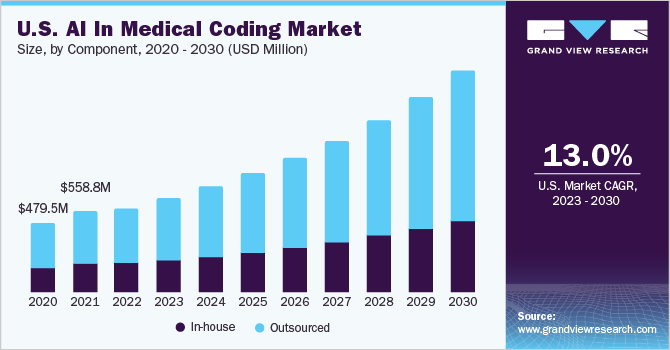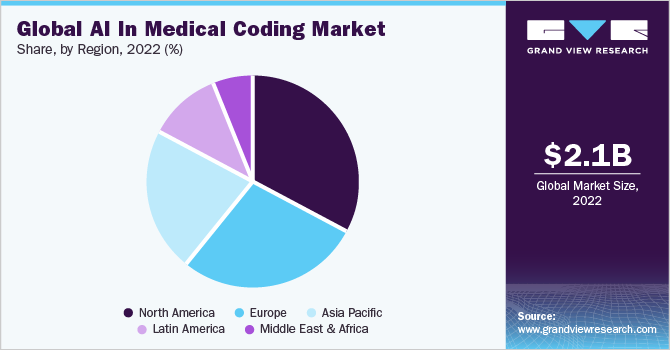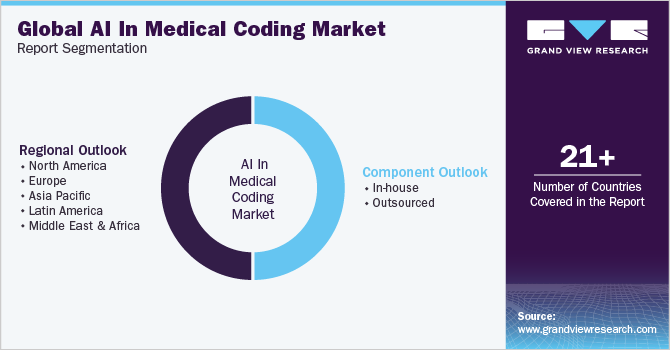
AI In Medical Coding Market Size, Share & Trends Analysis Report By Component (In-house, Outsourced), By Region (North America, Europe, APAC, Latin America, MEA), And Segment Forecasts, 2023 - 2030
- Report ID: GVR-4-68040-098-0
- Number of Report Pages: 90
- Format: PDF
- Historical Range: 2018 - 2021
- Forecast Period: 2023 - 2030
- Industry: Healthcare
Report Overview
The global AI in medical coding market size was estimated at USD 2.06 billion in 2022 and is expected to grow at a compound annual growth rate (CAGR) of 13.7% from 2023 to 2030. The market is experiencing growth due to several factors, including a growing demand for these services, a standardized language to minimize insurance claim fraud and misinterpretations, and a strong demand for improving efficiency in hospital billing and coding procedures. The demand for coding services is on the rise. For instance, according to the American Hospital Association's (AHA) Hospital Statistics 2022, there were approximately 33,356,853 hospital admissions across the U.S. This high number of admissions creates a significant need for medical billers and coders in the market, which is expected to drive the growth of the artificial intelligence (AI) in medical coding market.

The COVID-19 pandemic has significantly impacted the market by increasing the volume of healthcare data and creating a demand for efficient coding processes. This has fueled the adoption of AI-powered solutions. The shift to remote work and telehealth services has further accelerated the demand for these services, enabling remote coders to access and analyze medical records effectively. AI algorithms have played a crucial role in speeding up the coding process, extracting relevant information quickly, and reducing the burden on human coders.
These AI-powered coding systems have also addressed the rapid changes in coding guidelines and regulations during the pandemic, ensuring compliance and minimizing errors. Moreover, AI has supported data analysis and research efforts, providing insights from COVID-19 data for better understanding and public health interventions. The pandemic has emphasized the importance of resilient healthcare systems and increased recognition of AI's value in enhancing processes, data management, and future preparedness. As a result, the long-term impact of COVID-19 is expected to drive further growth and innovation in the artificial intelligence medical coding market.
AI in medical coding refers to applying artificial intelligence techniques and technologies in medical coding. Medical coding involves assigning standardized codes to procedures, healthcare professionals' diagnoses, and services. These codes are used for various purposes, such as billing, reimbursement, statistical analysis, and research. It leverages machine learning algorithms, Natural Language Processing (NLP), and other AI techniques to automate and improve the coding process. AI-powered coding systems can analyze medical records, extract relevant information, and suggest appropriate codes based on documented information. They can learn from historical coding patterns, coding guidelines, and feedback to continuously enhance their accuracy and efficiency.
There is a growing demand for a more streamlined and convenient coding and billing solution. Medical coding plays a crucial role in ensuring consistent documentation across various medical facilities. Medical coding companies enable healthcare administrations to analyze the frequency and effectiveness of treatments within their facilities, which is especially important for large medical establishments like tertiary-care hospitals. The market growth is expected to be driven by frequent product launches. For example, in March 2021, Athenahealth introduced the athenaOne Medical Coding Solution, an Electronic Health Record (EHR) coding solution designed to reduce the coding-related workload for clinicians and alleviate clinician burnout.
Mistakes in billing, fraudulent insurance activities, and misunderstandings of medical documents lead to significant financial losses. The growing inefficiency in medical billing and revenue cycle management results in increased demand for revenue cycle management services and medical coding software. Due to these reasons, the market for these services is expected to experience substantial growth. The adoption of digital technologies, such as electronic health records, revenue cycle management software, mhealth applications, and telehealth, as well as the ongoing efforts to digitize healthcare in the U.S., are contributing positively to this market growth. According to the Centers for Disease Control and Prevention, approximately 88.2% of physician offices in the U.S. were utilizing electronic health records in 2021.
However, certain factors may hinder the market's growth. These include the constantly changing regulations, concerns about data security, and the need for more adequately skilled Information Technology (IT) professionals in the healthcare sector.
Component Insights
The component segment consists of in-house and outsourced. The outsourced segment accounted for the highest revenue share of 68% in 2022. It is expected to grow at the fastest CAGR of 14.5% over the forecast period. Healthcare providers are opting to outsource their medical coding needs to minimize administrative expenses. This approach aids in cost reduction, time savings, and the streamlining of workflows. Consequently, healthcare providers can concentrate on providing high-quality patient care and enhancing patient engagement. The market growth is positively influenced by the increasing trend of offshoring and on-shoring revenue cycle management, including medical coding.
Companies often prefer outsourced AI in medical coding over in-house solutions for several reasons. Outsourcing allows healthcare organizations to leverage specialized expertise and resources from external vendors with in-depth knowledge and experience in AI and medical coding. These vendors are dedicated to developing and maintaining advanced AI algorithms and technologies specifically tailored for medical coding.
Outsourced AI solutions offer scalability, flexibility, and cost-effectiveness, as organizations can access cutting-edge technologies without investing in their development and maintenance. Additionally, outsourcing reduces the burden of hiring, training, and managing an in-house team, allowing healthcare organizations to focus on core healthcare operations while relying on trusted AI partners to deliver accurate and efficient coding solutions.
Regional Insights
North America held the largest revenue share of 31.8% in 2022. Due to technological advancements and improved healthcare infrastructure, the medical coding market in North America is projected to have a significant share throughout the forecast period. The growing burden of chronic diseases in various countries within the region is a key contributing factor to market expansion. For instance, the American Cancer Society predicts that the U.S. alone will witness 1,918,030 new cancer cases in 2022, thereby generating a need for efficient hospital billing procedures. As a result, the demand for medical coding services is expected to rise, driving market growth in the region.

The Asia Pacific region is expected to grow lucratively with a CAGR of 15.1% over the forecast period owing to increasing healthcare expenditure, technological advancements, growing healthcare infrastructure, rising burden of chronic diseases, government initiatives, and outsourcing opportunities. The region's focus on improving healthcare systems, adopting advanced technologies like AI, and establishing new healthcare facilities have contributed to the rising demand for efficient and accurate medical coding services, making APAC a thriving market for medical coding.
Key Companies & Market Share Insights
The key players adopt strategies such as partnerships, collaborations, and mergers & acquisitions, to gain a greater market position. Key stakeholders are introducing new products and services to increase their presence. For instance, in May 2023, Codametrix unveiled its Autonomous Bedside Pro (ABP) medical coding solution in collaboration with Henry Ford Health. The ABP solution allows clinicians to capture real-time clinical documentation, which is then analyzed by AI algorithms to generate accurate and compliant codes. This innovative solution reduces coding backlogs, improves efficiency, and enhances coding accuracy by eliminating the need for manual coding and streamlining the workflow.
Similarly, in March 2023, Clinion, a healthcare technology company, introduced an AI-powered medical coding solution for clinical trials. The solution enhances the efficiency, accuracy, and speed of medical coding in clinical trials. The advanced AI algorithms can quickly analyze and interpret vast amounts of clinical trial data, extract relevant information, and assign appropriate codes, significantly reducing the effort and time required for coding. Some prominent players in the global AI in medical coding market include:
-
IBM
-
Fathom, Inc.
-
Clinion
-
BUDDI.AI
-
CodaMetrix
-
aidéo technologies, LLC
-
Diagnoss
AI In Medical Coding Market Report Scope
|
Report Attribute |
Details |
|
Market size value in 2023 |
USD 2.33 billion |
|
Revenue forecast in 2030 |
USD 5.71 billion |
|
Growth rate |
CAGR of 13.7% from 2023 to 2030 |
|
Base year for estimation |
2022 |
|
Historical data |
2018 - 2021 |
|
Forecast period |
2023 - 2030 |
|
Quantitative units |
Revenue in USD million/billion, and CAGR from 2023 to 2030 |
|
Report coverage |
Revenue forecast, company share, competitive landscape, growth factors & trends |
|
Segments covered |
Component, region |
|
Regional scope |
North America; Europe; Asia Pacific; Latin America; Middle East and Africa |
|
Country scope |
U.S.; Canada; UK; Germany; France; Italy; Spain; Norway; Denmark; Sweden; China; Japan; India; Australia; South Korea; Thailand; Brazil; Mexico; Argentina; South Africa; Saudi Arabia; UAE; Kuwait |
|
Key Companies Profiled |
IBM; Fathom, Inc.; Clinion; BUDDI.AI; CodaMetrix; aidéo technologies, LLC; Diagnoss |
|
Customization scope |
Free report customization (equivalent up to 8 analysts working days) with purchase. Addition or alteration to country, regional & segment scope. |
|
Pricing and purchase options |
Avail customized purchase options to meet your exact research needs. Explore purchase options |
Global AI In Medical Coding Market Report Segmentation
This report forecasts revenue growth and provides an analysis of the latest trends in each of the sub-segments from 2018 to 2030. For this study, Grand View Research has segmented the global AI in medical coding market report based on component, and region:

-
Component Outlook (Revenue, USD Million, 2018 - 2030)
-
In-house
-
Outsourced
-
-
Regional Outlook (Revenue, USD Million, 2018 - 2030)
-
North America
-
U.S.
-
Canada
-
-
Europe
-
UK
-
Germany
-
France
-
Italy
-
Spain
-
Denmark
-
Sweden
-
Norway
-
-
Asia Pacific
-
Japan
-
China
-
India
-
Australia
-
South Korea
-
Thailand
-
-
Latin America
-
Brazil
-
Mexico
-
Argentina
-
-
Middle East & Africa
-
South Africa
-
Saudi Arabia
-
UAE
-
Kuwait
-
-
We are committed towards customer satisfaction, and quality service.
"The quality of research they have done for us has been excellent."




